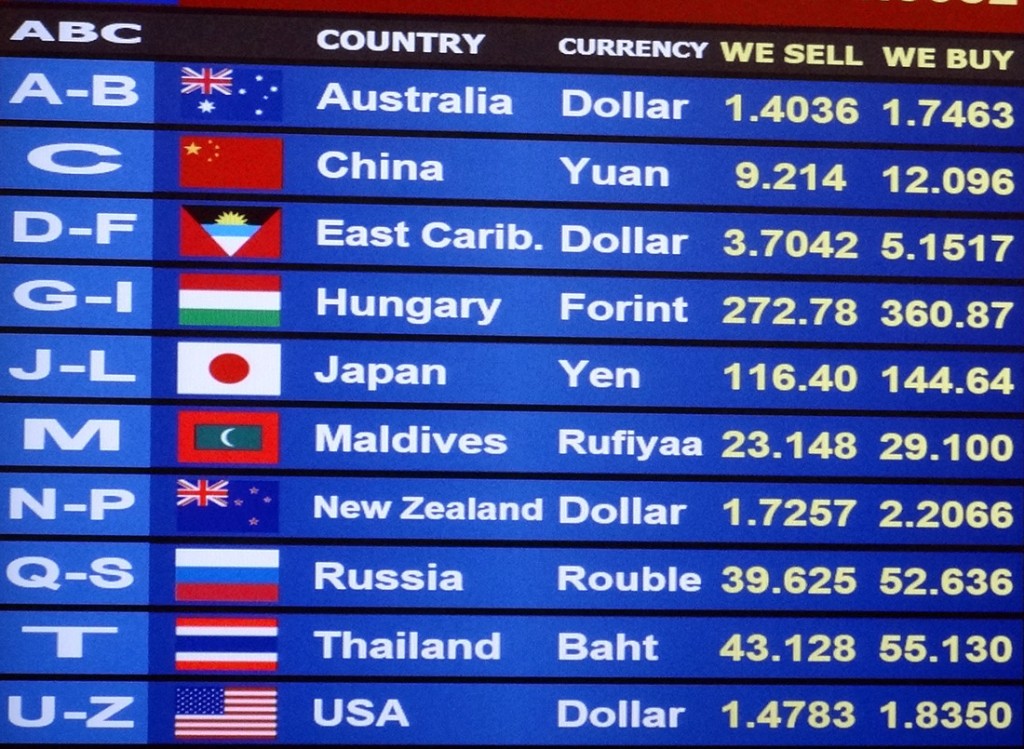 Compared with pre-financial crisis levels, the British pound is significantly weaker when measured against a basket of foreign currencies. In this blog we provide a further update of Appreciating a depreciating pound which was published back in early December 2012. The significance of the depreciation should be seen in the context of the UK as an open, island-economy where the ratio of exports to GDP in 2012 was close to 32%.
Compared with pre-financial crisis levels, the British pound is significantly weaker when measured against a basket of foreign currencies. In this blog we provide a further update of Appreciating a depreciating pound which was published back in early December 2012. The significance of the depreciation should be seen in the context of the UK as an open, island-economy where the ratio of exports to GDP in 2012 was close to 32%.
The competitiveness of our exports is, in part, affected by the exchange rate. Floating exchange rates are notoriously volatile. For example, some of the articles below show how sensitive the British pound can be latest news on the economy. However, since the autumn of 2007 we have observed a significant depreciation of the UK exchange rate. A depreciation helps to make our exports more competitive abroad and can potentially boost aggregate demand.
Rather than simply focus on bilateral exchange rates and so at the British pound separately against other foreign currencies, we can estimate an average exchange rate against a whole bundle of currencies. The average rate is calculated by weighting the individual exchange rates by the amount of trade between Britain and the other countries. This trade-weighted exchange rate is known as the effective exchange rate.
In analysing the competitiveness of the exchange rate, we can go one step further and adjust for the average (domestic currency) price of our exports relative to the average (foreign currency) price of those goods we import. Therefore, as well as the nominal (actual) effective exchange rate we can calculate a real effective exchange rate. If the average price of our exports rises relative to the average price of imports, the real effective exchange rate rises relative to the nominal rate. It means that we are able to obtain a larger volume of imports from selling a given volume of exports.
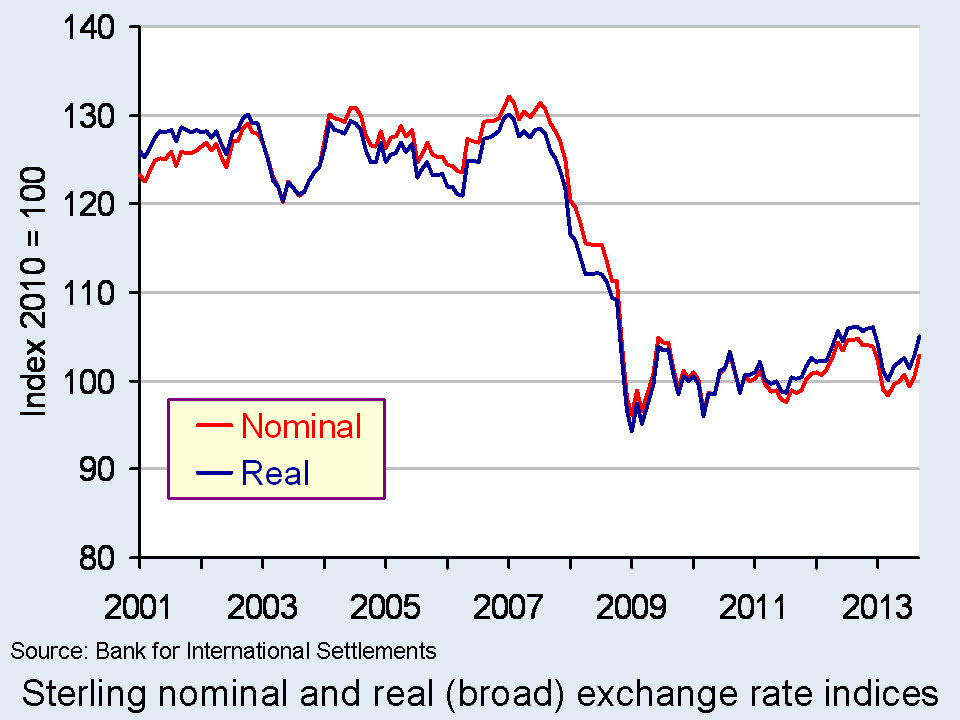 The chart shows the nominal (actual) and real effective exchange rate for the British pound since 2001. The chart shows clearly how from the autumn of 2007 the effective exchange rate fell sharply both in nominal and real terms.
The chart shows the nominal (actual) and real effective exchange rate for the British pound since 2001. The chart shows clearly how from the autumn of 2007 the effective exchange rate fell sharply both in nominal and real terms.
Over the period from July 2007 to January 2009 the nominal effective exchange rate fell by 26.8 per cent while the real effective exchange rate fell by 26.6 per cent. In other words, the British pound depreciated more than one-quarter over an 18-month period. In comparison, the American dollar rose by 5.3 per cent in nominal terms and by 1.9 per cent in real terms. (Click here to download a PowerPoint of the chart.)
If we move the clock forward, we observe an appreciation of the British pound between July 2011 and September 2012. Over this period, the British pound appreciated by 7.0 per cent in nominal terms and by 7.3 per cent in real terms. However, this appreciation had effectively been wiped-out when by March 2013 the nominal rate had depreciated by 6.1 per cent and by 5.6 per cent in real terms. Subsequently, there has been a slight appreciation once more. As of September, the nominal rate had risen by 4.5 per cent and the real rate by 4.8 per cent.
While, as recent figures help to demonstrate, the British pound continues on its roller-coaster ride, there has been a very marked depreciation since the giddy-days prior to the financial crisis. The facts show that when comparing the effective exchange rate in September 2013 with July 2007 the British pound was 21.8 per cent lower in nominal terms and 18.3 per cent in real terms. Over the same period, the US dollar, for example, was only 1.3 per cent lower in nominal terms and 6.1 per cent in real terms. This constitutes a major competitive boost for our exporters. Nonetheless, there remain uncertainty about just how much British exporters can take advantage of this, the amount that it will boost British growth and the impact it will make on the country’s chronic balance of trade deficit in goods which was close to 7 per cent of GDP in 2012.
Data
Statistical Interactive Database – interest and exchange rate rates data Bank of England
BIS effective exchange rate indices Bank for International Settlements
Market Data: Currencies BBC News
Recent Articles
Unexpected drop in factory output dents sterling Reuters UK, Jessica Mortimer (9/10/13)
Pound Forecasts Soar as BOE’s Carney Signals Shift: Currencies Bloombeg, Lukanyo Mnyanda and Emma Charlton (19/10/13)
Pound Advances as U.K. Financial Optimism Improves; Gilts Rise Bloombeg, Emma Charlton (7/10/13)
Re-balancing and the re-industrialisation of Britain BBC News, Linda Yueh (13/10/13)
Signs of recovery abound but with little consensus on future course Financial Times, Chris Giles and Sarah O’Connor (31/10/13)
Previous Articles
Pound depreciates Vs dollar to lowest level since Aug 16 Bloomberg, Emma Charlton (5/2/13)
Pound advances against euro on Italy speculation; Gilts decline Bloomberg, Lucy Meakin and David Goodman Alice Ross (4/3/13)
Pounding of sterling risks a currency war Scotland on Sunday, Bill Jamieson (17/2/13)
Credit ratings, the pound, currency movements and you BBC News, Kevin Peachey (25/2/13)
The Bank of England can’t just go on doing down the pound Telegraph, Jeremy Warner (21/2/13)
 Sterling will continue to go down BBC News, Jim Rogers (25/2/13)
Sterling will continue to go down BBC News, Jim Rogers (25/2/13)
Questions
- Explain how the foreign demand for goods and assets generates a demand for British pounds. How will this demand be affected by the foreign currency price of the British pound, i.e. the number of foreign currency units per £1?
- Explain how the demand by British residents for foreign goods and assets generates a supply of British pounds. How will this supply be affected by the foreign currency price of the British pound, i.e. the number of foreign currency units per £1?
- What factors are likely to shift the demand and supply curves for British pounds on the foreign exchange markets?
- Illustrate the effect of a decrease in the demand for British goods and assets on the exchange rate (i.e. the foreign currency price of the British pound) using a demand-supply diagram.
- What is the difference between a nominal and a real effective exchange rate? Which of these is a better indicator of the competitiveness of our country’s exports?
- What factors are likely to have caused the depreciation of the British pound since 2007?
- What is meant by a deficit on the balance of trade in goods?
- What relationship exists between the demand and supply of currencies on the foreign exchange markets and the balance of payments?
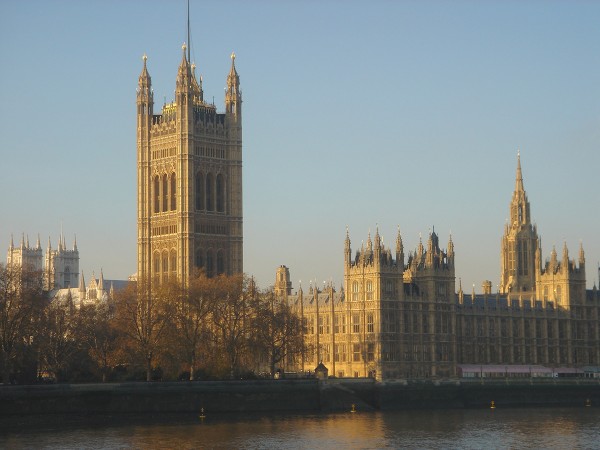 There has been an interesting debate recently about whether the austerity policies being pursued in the UK are the correct ones. What would have happened if the government had pursued a more expansionary policy? Would the increase in borrowing, at least in the short term, have triggered a financial crisis?
There has been an interesting debate recently about whether the austerity policies being pursued in the UK are the correct ones. What would have happened if the government had pursued a more expansionary policy? Would the increase in borrowing, at least in the short term, have triggered a financial crisis?
Without austerity policies, would the eurozone crisis have led to a collapse in investor confidence in the UK, especially if Greece had been forced out of the euro?
On the one side, Kenneth Rogoff argues that increasing the UK’s budget deficit would have been dangerous and could have led to a flight from the pound. Generally, but with some reservations, he supports the fiscal policies that have been pursued by the Coalition.
I am certainly not arguing that the UK or other advanced countries handled the post-crisis period perfectly. There should have been more infrastructure spending, even more aggressive monetary policy and probably more ruthless bank restructuring. But there has to be a balance between stimulus and stability. To assume we always knew things would calm down, and to retrospectively calibrate policy advice accordingly, is absurd
Paul Krugman and Simon Wren-Lewis challenge Rogoff’s arguments. Paul Krugman uses a version of the IS-LM model to analyse the effect of a loss of international confidence in the UK following problems in the eurozone and worries about excessive UK borrowing.
In the model, the LM curve (labelled MP in Krugman’s diagrams) illustrates the effect of an increase in real GDP on interest rates with a particular monetary policy (e.g. an inflation target or a Taylor rule, 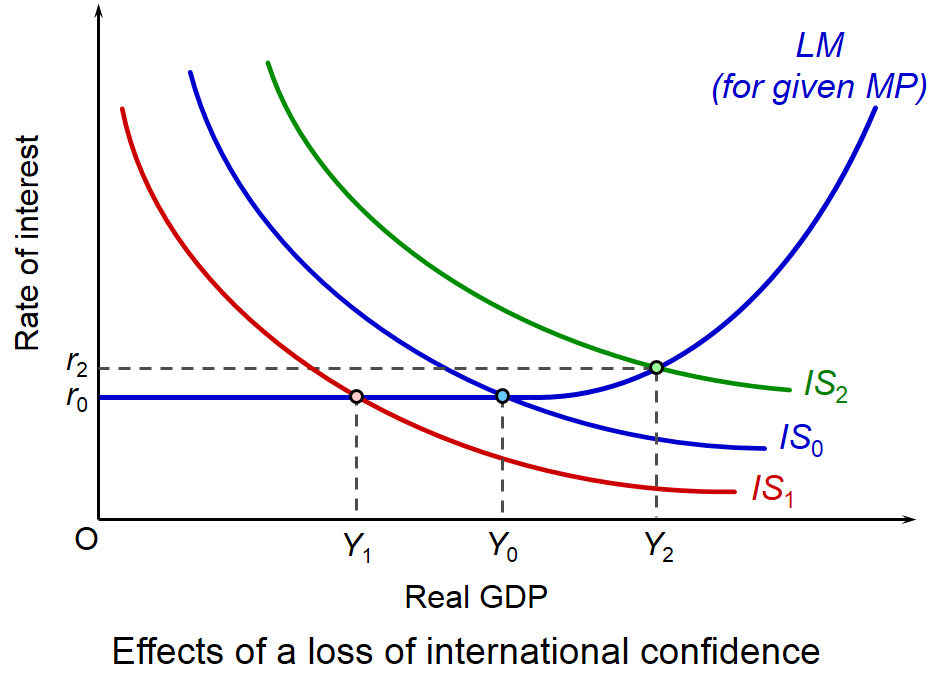 which involves a mix of two policy objectives: an inflation target and real GDP). As GDP rises, putting upward pressure on inflation, so the central bank will raise interest rates. Hence, like the traditional LM curve, the monetary-policy related LM curve will slope upwards, as shown in the diagram.
which involves a mix of two policy objectives: an inflation target and real GDP). As GDP rises, putting upward pressure on inflation, so the central bank will raise interest rates. Hence, like the traditional LM curve, the monetary-policy related LM curve will slope upwards, as shown in the diagram.
Initial equilibrium GDP is Y0. The rate of interest is at the minimum level, r0 (i.e. the rate of 0.5% that the Monetary Policy Committee has set since January 2009). This, in the model, is the liquidity trap, where any increase in money supply (a rightward shift in the LM curve) will have no effect on interest rates or GDP.
In Rogoff’s analysis of a crisis triggered by excessive borrowing and problems in the eurozone, the IS curve will shift to the left (as illustrated by curve IS1) as capital flows from the UK and confidence collapses. Real GDP will fall to Y1. This will be the outcome of fiscal expansion in the world of the early 2010s.
 Krugman argues that the opposite will occur. The outflow of capital will drive down the exchange rate. This will lead to an increase in exports and a decrease in imports. Aggregate demand thus rises and the IS curve will shift to the right (e.g. to IS2 in the diagram. Real GDP will rise (e.g. to Y2 in the diagram). If the rise in aggregate demand is sufficient, the economy will rise out of the liquidity trap and interest rates will rise (e.g. to r2 in the diagram).
Krugman argues that the opposite will occur. The outflow of capital will drive down the exchange rate. This will lead to an increase in exports and a decrease in imports. Aggregate demand thus rises and the IS curve will shift to the right (e.g. to IS2 in the diagram. Real GDP will rise (e.g. to Y2 in the diagram). If the rise in aggregate demand is sufficient, the economy will rise out of the liquidity trap and interest rates will rise (e.g. to r2 in the diagram).
Not surprisingly, Rogoff challenges this analysis, as you will see if you read his second paper below. He doesn’t criticise the model per se, but challenges Krugman’s assumptions. For example, a depreciation of sterling by some 20% since 2008 doesn’t seem to have had a major effect in stimulating exports (see the chart in the news item, A balancing act). And exports could well have declined if the eurozone economy had collapsed, given that exports to the eurozone account for around 44% of total UK exports.
Rogoff’s assumptions in turn can be challenged. Simon Wren-Lewis argues that, provided a credible long-term plan for deficit reduction is in place, maintaining a fiscal stimulus in the short run, to keep the recovery going that was beginning to emerge in 2010, would help to increase investor confidence, not undermine it. And, with a policy of quantitative easing, which involves the Bank of England buying central government debt, there is no problem of a lack of demand for UK gilts by the private sector.
What is clear from this debate is the willingness of both sides to accept points made by the other. It is an extremely civilised debate. In fact, it could be seen as a model of how academic debate should be conducted. There is none of the ‘shouting’ that has charaterised much of the pro- and anti-austerity lobbying since the financial crisis burst onto the world stage.
Britain should not take its credit status for granted Scholars at Harvard from Financial Times, Kenneth Rogoff (3/10/13)
Ken Rogoff on UK austerity mainly macro, Simon Wren-Lewis (3/10/13)
Phantom Crises (Wonkish) The Conscience of a Liberal, Paul Krugman (3/10/13)
Three Wrongs do not make a Right Scholars at Harvard from Financial Times, Kenneth Rogoff (7/10/13)
Is George Osborne really a hero of global finance? The Guardian, Robert Skidelsky (24/10/13)
Questions
- Explain how the policy-dependent LM curve illustrated in the diagram is derived.
- What would cause the policy-dependent LM curve to shift?
- Explain what is meant by the ‘liquidity trap’. Why does being in a liquidity trap make monetary policy ineffective?
- How would you determine whether or not the UK is currently in a liquidity trap?
- How is the level of (a) public-sector debt and (b) private sector debt owed overseas likely to affect the confidence of investors concerning the effects of an expansionary fiscal policy?
- Compare the UK’s total external debt with that of other countries (see the following tables from Principal Global Indicators, hosted by the IMF: External debt and Short-term external debt).
- What insurance policy (if any) does the UK have to protect against market panic about the viability of UK debt?
- What areas of agreement are there between Rogoff on the one side and Krugman and Wren-Lewis on the other?
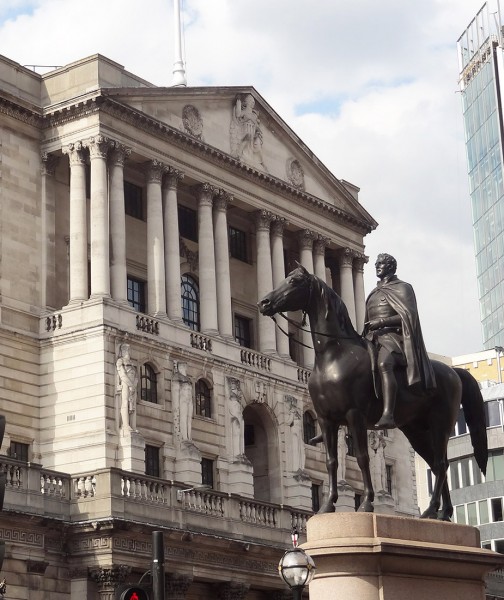 In an interview with the Yorkshire Post, Mark Carney, Governor of the Bank of England, said that under current circumstances he did not feel that further quantitative easing was justified. He said:
In an interview with the Yorkshire Post, Mark Carney, Governor of the Bank of England, said that under current circumstances he did not feel that further quantitative easing was justified. He said:
My personal view is, given the recovery has strengthened and broadened, I don’t see a case for quantitative easing and I have not supported it.
In response to his speech, the pound strengthened against the dollar. It appreciated by just over 1 cent, or 0.7%. But why should the likelihood of no further quantitative easing lead to a strengthening of the pound?
The answer lies with people’s anticipation of future interest rates. If there is no further increase in money supply through QE, interest rates are likely to rise as the economy recovers and thus the demand for money rises. 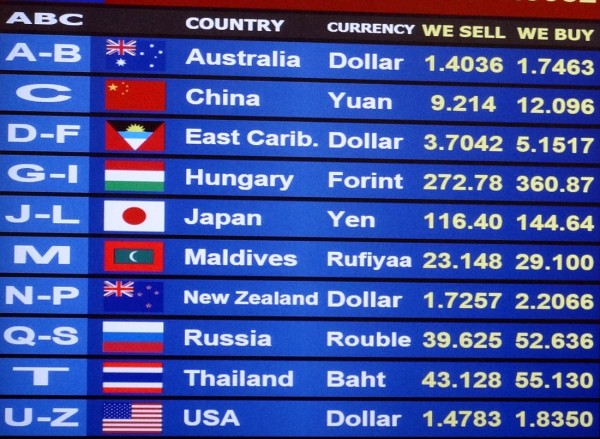 A rise in interest rates, in turn, is likely to lead to an inflow of finance into the country, thereby boosting the financial account of the balance of payments. The increased demand for sterling will tend to drive up the exchange rate.
A rise in interest rates, in turn, is likely to lead to an inflow of finance into the country, thereby boosting the financial account of the balance of payments. The increased demand for sterling will tend to drive up the exchange rate.
However, an increase in aggregate demand will result in an increase in imports and a likely increase in the balance of trade deficit. Indeed, in July (the latest figures available) the balance of trade deficit rose to £3.085bn from £1.256bn in June. As recovery continues, the balance of trade deficit is likely to deteriorate further. Other things being equal, this would lead to a depreciation of the pound.
So if the pound appreciates, this suggests that the effect on the financial account is bigger than the effect on the current account – or is anticipated to be so. In fact, given the huge volumes of short-term capital that move across the foreign exchanges each day, financial account effects of interest rate changes – actual or anticipated – generally outweigh current account effects.
Articles
Yorkshire can reap benefits from turnaround says Mark Carney Yorkshire Post (27/9/13)
Sterling Jumps as BOE Chief Signals No More Bond Buying Wall Street Journal, Nick Cawley and Jason Douglas (27/9/13)
Carney’s Northern Exposure Sends Sterling Soaring Wall Street Journal, David Cottle (27/9/13)
Pound Gains as Carney Sees No Case for QE, Confidence Improves Bloomberg, Anchalee Worrachate & David Goodman (28/9/13)
Exchange Rate Bounces as Strong UK Data Supports Sterling FCF (Future Currency Forecast), Laura Parsons (30/9/13)
Currency briefing: What if the pound sterling has been overbought? iNVEZZ, Tsvyata Petkova (30/9/13)
Pound rises after Carney rejects increasing QE BBC News (27/9/13)
Pound Rises for Fourth Day Versus Euro on Housing, Mortgage Data Bloomberg, Emma Charlton (30/9/13)
Data
$ per £ exchange rate (latest month) XE (You can access other periods and currencies)
Effective exchange rate indices (nominal and real) Bank for International Settlements
Balance of Payments, Q2 2013 Dataset ONS
Questions
- Explain how quantitative easing affects exchange rates.
- What is happening concerning quantitative easing in the USA? How is this likely to affect the exchange rate of the US dollar to sterling; other currencies to sterling?
- Why may an increase in the balance of trade deficit lead directly to an appreciation of the exchange rate?
- Why is an anticipation of a policy change likely to have more of an effect on exchange rates than the actual policy change itself? Why, indeed, may a policy change have the reverse effect once it is implemented?
- Under what circumstances may speculation against exchange rate changes be (a) stabilising; (b) destabilising?
- How is quantitative easing (or an anticipation of it) likely to affect each of the main components of the current and financial accounts of the balance of payments?
- For what reasons might sterling have been ‘overbought’ and hence be overvalued?
- What is meant by the real exchange rate (REER)? Why may reference to the REER suggest that sterling is not currently overvalued?
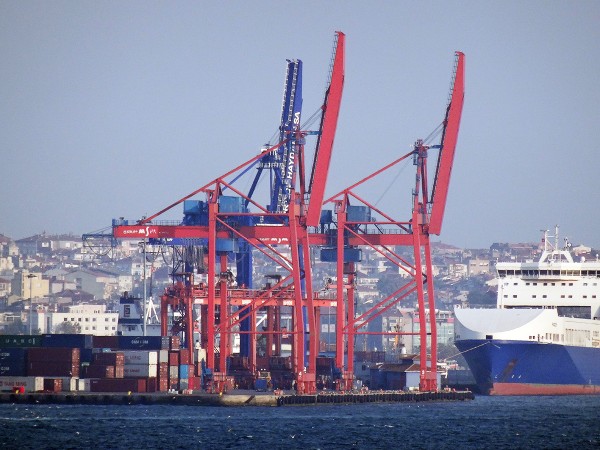 Turkey has experienced rapid economic growth in recent years and has attracted large inflows of foreign capital. The chart below illustrates how growth in real GDP in Turkey in most years since 2000 has considerably exceeded that in the OECD as a whole (click here for a PowerPoint). As you can see from the chart, growth in Turkey over the period has averaged 4.5%, while that in the OECD has averaged just 1.8%.
Turkey has experienced rapid economic growth in recent years and has attracted large inflows of foreign capital. The chart below illustrates how growth in real GDP in Turkey in most years since 2000 has considerably exceeded that in the OECD as a whole (click here for a PowerPoint). As you can see from the chart, growth in Turkey over the period has averaged 4.5%, while that in the OECD has averaged just 1.8%.
Indeed, Turkish growth has been compared with that of the BRICs (Brazil, Russia, India and China). However, like the BRICs, Turkey has been experiencing slowing growth in the past few months. Indeed, the slowdown has been especially marked in Turkey.
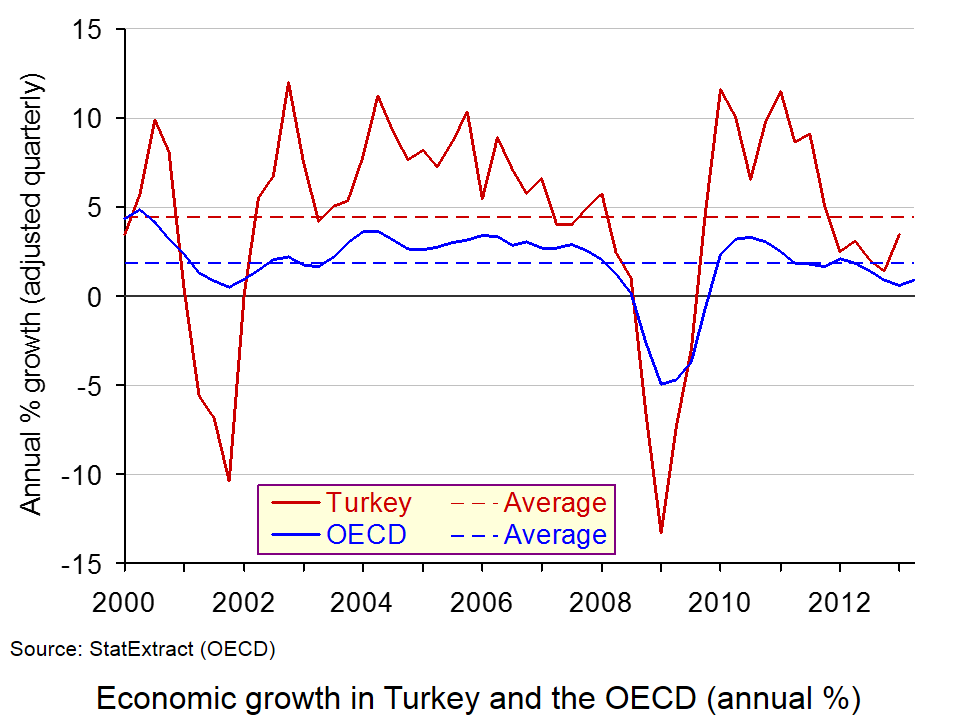 In recent years Turkey has benefited from large inflows of foreign capital. Partly these were direct investment flows, encouraged by a large and rapidly growing internal market, boosted by a rapid expansion of consumer credit, and also by a growing export sector. But to a large extent, especially in recent years, there has been a large rise in portfolio and other investment inflows. This has been encouraged by a large increase in global money supply resulting from policies of quantitative easing in the USA and other developed countries.
In recent years Turkey has benefited from large inflows of foreign capital. Partly these were direct investment flows, encouraged by a large and rapidly growing internal market, boosted by a rapid expansion of consumer credit, and also by a growing export sector. But to a large extent, especially in recent years, there has been a large rise in portfolio and other investment inflows. This has been encouraged by a large increase in global money supply resulting from policies of quantitative easing in the USA and other developed countries.
 But the economic climate has changed. First investors have become worried about the conflict in Syria escalating and this impacting on Turkey. Second Turkey’s large financial account surpluses have allowed it to run large current account deficits and have maintained a high exchange rate. Third the tapering off and possible reversal of quantitative easing have led to recent outflows of finance from various countries perceived as being vulnerable, including Turkey.
But the economic climate has changed. First investors have become worried about the conflict in Syria escalating and this impacting on Turkey. Second Turkey’s large financial account surpluses have allowed it to run large current account deficits and have maintained a high exchange rate. Third the tapering off and possible reversal of quantitative easing have led to recent outflows of finance from various countries perceived as being vulnerable, including Turkey.
The effect of this has been a depreciation of the Turkish lira and upward pressure on inflation. The lira has fallen by 14% since the beginning of 2013 and by nearly 7% since the beginning of August alone.
The question is whether the supply side of the Turkish economy has become robust enough to allow the country to ride out its current difficulties. Will foreign investors have sufficient faith in the long-term potential of the Turkish economy to continue with direct investment, even if short-term financial inflows diminish?
Articles
Turkey’s economy faces uncertainties amid possible military intervention in Syria Xinhua, Fu Peng (29/8/13)
Turkey may cut 2014 growth target to 4% Turkish Daily News (8/9/13)
Turkish lira at record low, threatening growth Daily News Egypt (7/9/13)
Turkish lira may need higher interest rates to escape emerging markets rout Reuters, Sujata Rao and Seda Sezer (20/8/13)
Turkey Economic Crisis: Crises from Both Sides Wealth Daily, Joseph Cafariello (9/8/13)
Western financial prescription has made Turkey ill The Observer, Heather Stewart (1/9/13)
Turkish Deputy PM Babacan calm amid economic fluctuations Turkish Daily News (8/9/13)
 The Fragile Five BBC News, Linda Yueh (26/9/13)
The Fragile Five BBC News, Linda Yueh (26/9/13)
Data
Economic growth rates (annual) for Turkey, Brazil, Russia, India and China: 2000–13 IMF Economic Outlook Database (April 2013)
Quarterly growth rates of real GDP for OECD countries and selected other countries and groups of countries OECD StatExtracts
Turkey and the IMF IMF
Turkey: data World Bank
Links to Turkish Official Statistics Offstats
Country statistical profile: Turkey OECD Country Statistical Profiles
Spot exchange rate, Turkish Lira into Dollar Bank of England
Questions
- Why has the Turkish economy experienced such rapid growth in recent years and especially from 2010 to 2012?
- Why has Turkish growth slowed over the past year?
- Why has “Western financial prescription made Turkey ill”
- Why has the Turkish lira depreciated? What has determined the size of this depreciation?
- What are the beneficial and adverse effects of this depreciation?
- Why must any surplus on the combined financial and capital accounts of the balance of payments be matched by a corresponding deficit on the current account?
- How is a tapering off of quantitative easing likely to impact on developing countries? What will determine the size of this impact?
- Istanbul has lost its bid to host the 2020 Olympic Games? How is this likely to affect the Turkish economy?
 The rate of growth in India has fallen to its lowest level since the first three months of 2009 – the period when many countries were plunging into recession. Although the annual rate was still 4.4% in Q2 2013 (a rate most Western governments would love to achieve!), it had averaged 8.2% from 2003 to 2007 and 9.5% from 2010 to 2011 (see).
The rate of growth in India has fallen to its lowest level since the first three months of 2009 – the period when many countries were plunging into recession. Although the annual rate was still 4.4% in Q2 2013 (a rate most Western governments would love to achieve!), it had averaged 8.2% from 2003 to 2007 and 9.5% from 2010 to 2011 (see).
And the rupee has been falling in value (see chart below). The exchange rate of the rupee to the dollar has depreciated by 21% since the start of the year and by 14% since the beginning of August (click here for a PowerPoint of the chart). This has pushed up the price of imports and raised fears that inflation, already approaching 10%, will rise.
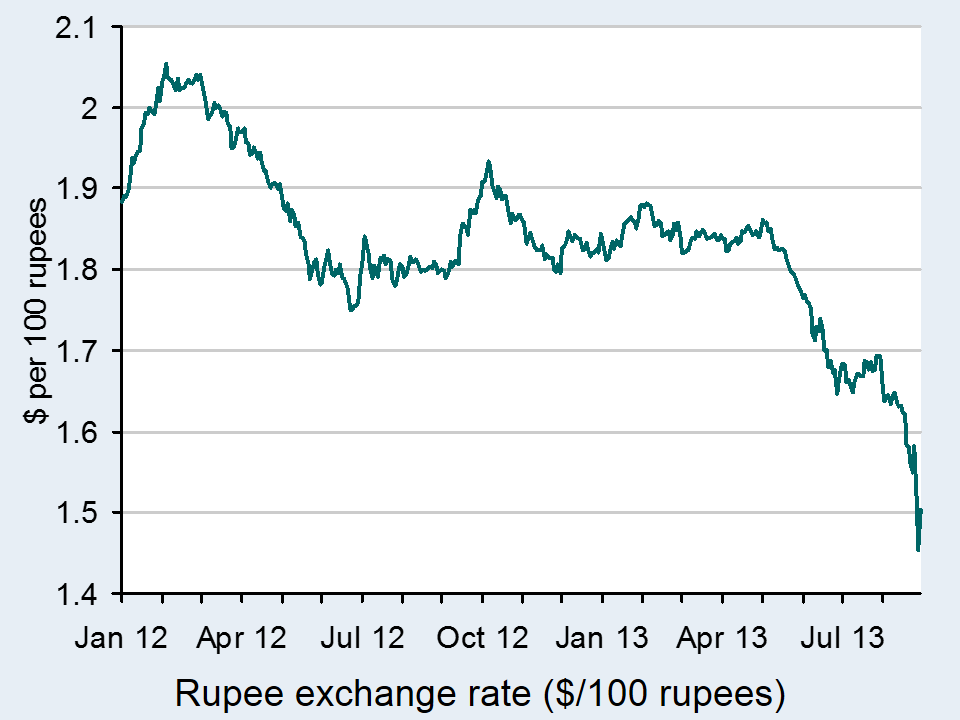 There have also been concerns about the health of India’s banking sector, with worries over the possible rise in bad loans.
There have also been concerns about the health of India’s banking sector, with worries over the possible rise in bad loans.
One result of all these factors is that the confidence of investors has been shaken. Bond prices have fallen and so too have share prices. The Mumbai Sensex index fell by 11.5% from 22 July to 27 August. Worried about possible capital flight, the Indian government imposed capital controls on Indian residents on 14 August. It has, however, since ruled out limiting the outflow of funds by foreign investors.
The following articles and videos look at the causes of the current economic problems and what can be done about them.
Webcasts
 India’s sliding economy Aljazeera (24/8/13)
India’s sliding economy Aljazeera (24/8/13)
 Economic woes grow for Indians as rupee continues to slide BBC News, Sanjoy Majumder (30/8/13)
Economic woes grow for Indians as rupee continues to slide BBC News, Sanjoy Majumder (30/8/13)
 What is behind the Indian economy’s fall from grace? BBC News, Yogita Limaye (30/8/13)
What is behind the Indian economy’s fall from grace? BBC News, Yogita Limaye (30/8/13)
 Indian rupee: How onions reflect health of economy BBC News, Nitin Srivastava (30/8/13)
Indian rupee: How onions reflect health of economy BBC News, Nitin Srivastava (30/8/13)
 The rise and fall of India’s economy NDTV (20/8/13)
The rise and fall of India’s economy NDTV (20/8/13)
 Is the Indian economy heading for a doom? NDTV, Dr Arvind Virmani, Adi Godrej, P N Vijay, Sanjay Nirupam and Prakash Javadekar (20/7/13)
Is the Indian economy heading for a doom? NDTV, Dr Arvind Virmani, Adi Godrej, P N Vijay, Sanjay Nirupam and Prakash Javadekar (20/7/13)
 Can Rajan stabilise India’s economy? FT Video, Stuart Kirk and Julia Grindell (7/8/13)
Can Rajan stabilise India’s economy? FT Video, Stuart Kirk and Julia Grindell (7/8/13)
Articles
India in trouble: The reckoning The Economist (24/8/13)
PM warns of short term shocks, attacks BJP for stalling Parliament The Economic Times of India (31/8/13)
External global factors led to rupee slide: Manmohan in Lok Sabha Hindustan Times (30/8/13)
India seeks allies to defend rupee as growth skids to four-year low Reuters, Manoj Kumar and Frank Jack Daniel (30/8/13)
Rupee charts in uncharted territory Reuters, Saikat Chatterjee and Subhadip Sircar (30/8/13)
Indian Prime Minister Says Rupee Crisis Will Only Make Country Stronger Time World, ilanjana Bhowmick (30/8/13)
Is India in danger of another crisis? BBC News, Linda Yueh (8/8/13)
India’s GDP shows continuing slowdown BBC News (30/8/13)
Slowest India Growth Since 2009 Pressures Singh to Support Rupee Bloomberg, Unni Krishnan (30/8/13)
Questions
- Why has the rupee fallen in value so dramatically? Is there likely to have been overshooting?
- What are the economic consequences of this large-scale depreciation? Who gain and who lose?
- What factors are likely to affect the rate of growth in India over the coming months?
- Why is the Indian economy more vulnerable than many other Asian economies?
- What economic policies are being pursued by the Indian government? How successful are they likely to be?
 Compared with pre-financial crisis levels, the British pound is significantly weaker when measured against a basket of foreign currencies. In this blog we provide a further update of Appreciating a depreciating pound which was published back in early December 2012. The significance of the depreciation should be seen in the context of the UK as an open, island-economy where the ratio of exports to GDP in 2012 was close to 32%.
Compared with pre-financial crisis levels, the British pound is significantly weaker when measured against a basket of foreign currencies. In this blog we provide a further update of Appreciating a depreciating pound which was published back in early December 2012. The significance of the depreciation should be seen in the context of the UK as an open, island-economy where the ratio of exports to GDP in 2012 was close to 32%. The chart shows the nominal (actual) and real effective exchange rate for the British pound since 2001. The chart shows clearly how from the autumn of 2007 the effective exchange rate fell sharply both in nominal and real terms.
The chart shows the nominal (actual) and real effective exchange rate for the British pound since 2001. The chart shows clearly how from the autumn of 2007 the effective exchange rate fell sharply both in nominal and real terms. Sterling will continue to go down BBC News, Jim Rogers (25/2/13)
Sterling will continue to go down BBC News, Jim Rogers (25/2/13)








